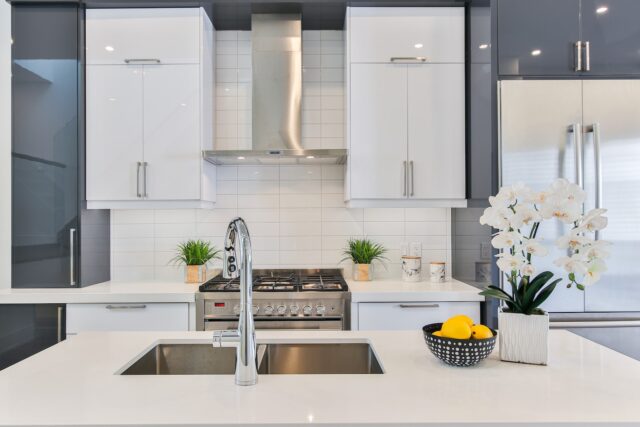
Being a uniting and inspiring part of any house, the kitchen is also a place where delicious masterpieces are created, and free-hearted family discussions are held. This is the most visited area of your home: preparing & cooking meals, fetching a glass of water, and having meals together (for open-plan kitchens). Hence, dealing with puddles under a sink is an extremely frustrating experience.
Based on the scale of the problem, the leaky sink repair might require qualified help. In case you wonder, “Why is my kitchen sink leaking?” and you are doubtful of whether you can fix it on your own or you have to contact repair service ASAP, look through the most commonly encountered reasons for kitchen sink leaking specified below.
Commonly encountered causes of the leaky sink
Worn out O-ring. A small rubber disk helps to keep the faucet in place. In fact, o-rings have limited wear resistance and require replacement regularly. Eventually, o-rings get loose or wear out and need replacement. In fact, the task doesn’t require specific knowledge or skills, and many homeowners replace O-rings with no trouble. If the problem persists, you’d better look for other possible causes of the leak or request qualified help.
Defective or leaking faucet. The same as any other fixture, a faucet has a limited lifespan. When a leak is not caused by damaged gaskets, the problem can be in a faulty faucet. The solution is to change the faucet. Note: it is important to use high-quality washers and gaskets to ensure a watertight connection. However, reputable brands usually include washers & o-rings in their in-house faucet kits.
Choked P-trap. Definitely, you’ve seen that curved plastic pipe running under your sink – this is a P-trap. Designed specifically to facilitate the removal of wastewater and keep sewer gas from rising back into the plumbing, this part is particularly prone to clogging. Food leftovers, gunk, and debris of all sorts can block the water flow, lead to sink overflow or result in untimely/early wear of the P-trap itself.
Water supply connection issues. Problems due to faulty water supply connections can stay unnoticeable for a while until you will discover puddles under the sink or soaked cabinets. In fact, water can drip because the connection gaskets are worn out or corrosion on any steel elements, if available. In most cases, you can solve the issue by tightening the connection or changing the loose gasket. In case the problem persists, you’d better request professional services.
High water pressure. Most people find low water pressure very annoying; however, excessive pressure within a water supply pipeline might be damaging as the water hits pipes hard. Pipes can wear out faster, crack, or, in the worst case, burst. Too much high water pressure can be the reason that a small leak will spring, leading to huge ponds on the floor. Once you have noticed the signs, call a reliable contractor (or plumber) promptly. An experienced specialist can check water pressure, replace damaged parts, and make the necessary adjustments to prevent potential damage in the future.
Worn out drain sealant. This is probably one of the most typical causes of leakage. Whenever you notice the kitchen sink leaking underneath, check the drain connection in the first place. Typically, a plumber uses sealant to ensure a waterproof connection. Over time, the sealant can get loose or dry out, so water drips. Actually, the drain itself also can be worn out beyond repair. In this instance, do not experiment with DIY solutions picked from YouTube; instead, contact a reliable contractor to fix the problem.
Worn washers. Every time we use faucets, washers are pressed in valve seats, and eventually, friction leads to wear. If you spot water dripping around and down the spout, you probably just need to change the washers. This situation is particularly common for sinks equipped with compression faucets.
Corrosion of the valve seat. A small valve is seated within a compression mechanism connecting the faucet with the spout. Over time, water can collect, causing corrosion of the valve seat and, consequently, leaking. In this instance, you have to seek pros to manage the issue, as the rusted valve most likely must be replaced.
What you should do when you spot leakage
Once you’ve noticed a leak, you can try to figure out the cause using the list above. Obviously, using buckets or drying the floor beneath the sink isn’t a solution. You need to eliminate the problem. If the reason is a worn O-ring or washer, you can try to replace the damaged item on your own. If water stopped dripping beneath the sink — done, voila! Congratulations!
If the problem persists or you don’t feel skilled enough or confident of what to do, this is high time to call professionals.
When to call pros without trying DIY solutions watched on YouTube: once you’ve spotted damp areas or weird odor without any obvious reason, contact a trustworthy contractor to inspect the space thoroughly using dedicated tools, detect an issue, and fix it ensuring the safety of your home and the peace of mind for the homeowner. The unpleasant odor may be the result of mold infestation, which is toxic to both humans & pets. Mold diagnostics and treatment require special equipment, so do not put off calling pros.
In Conclusion
Now that you better understand what might be the reason behind the kitchen sink leaking, the entire situation should seem as stressful as before, and you can simply change that damaged O-ring or contact specialists with expertise in leaky sink repair. In any case, you’d better eliminate the cause of leakage as fast as possible to avoid additional issues, such as mold growth incited by high humidity levels in the closed space under the sink.
Tip: Remember to inspect the space beneath the sink regularly. The sooner you spot the leakage and tackle a problem, the less the repair work will cost you.








